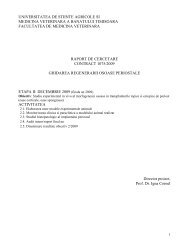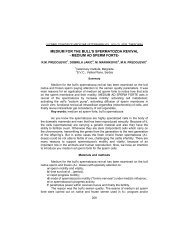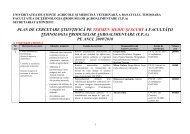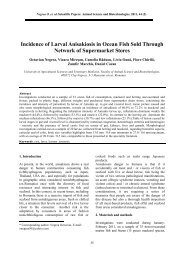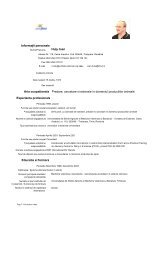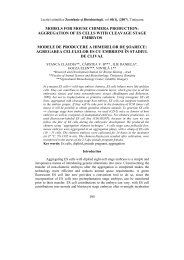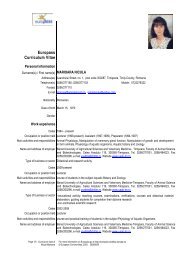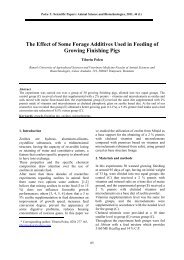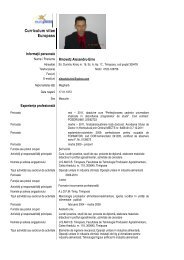Solutions for Destination Management on Agri-Tourism Farm
Solutions for Destination Management on Agri-Tourism Farm
Solutions for Destination Management on Agri-Tourism Farm
Create successful ePaper yourself
Turn your PDF publications into a flip-book with our unique Google optimized e-Paper software.
Petroman I. et. al./Scientific Papers: Animal Sciences and Biotechnologies, 2012, 45 (1)<br />
health; acquiring the skills necessary in public<br />
relati<strong>on</strong>s: communicati<strong>on</strong> skills; inter-pers<strong>on</strong>al<br />
skills; patience.<br />
In order to achieve these goals, we need to<br />
observe a very detailed programme of the<br />
implementati<strong>on</strong> of rural agri-tourism or farm<br />
tourism activities and the principles of destinati<strong>on</strong><br />
management [8, 11].<br />
2. Materials and methods<br />
To achieve this scientific approach, we have<br />
analysed in detail the way in which destinati<strong>on</strong><br />
management impacts the development of a<br />
potentially real agri-tourism area to develop<br />
soluti<strong>on</strong>s that c<strong>on</strong>tribute to the improvement of<br />
destinati<strong>on</strong> management <strong>on</strong> agri-tourism farms<br />
that develop both agricultural (plant growing and<br />
animal breeding) and agri-tourism activities. The<br />
reas<strong>on</strong> why we insist <strong>on</strong> this aspect is that, <strong>on</strong> <strong>on</strong>e<br />
hand, <str<strong>on</strong>g>for</str<strong>on</strong>g>eign tourists interested in this type of<br />
tourism are already familiarised with this hybrid<br />
tourism and, <strong>on</strong> the other hand, Romanian tourists<br />
possibly interested in this type of tourism are not<br />
at all attracted by the perspective of carrying out<br />
agricultural activities: we should, there<str<strong>on</strong>g>for</str<strong>on</strong>g>e, offer<br />
them something else besides fruit picking or farm<br />
activities, e.g. some <str<strong>on</strong>g>for</str<strong>on</strong>g>m of entertainment.<br />
3. Results and discussi<strong>on</strong><br />
One of the most important aspects of management<br />
in farm tourism is, no matter the type of tourism<br />
practiced, destinati<strong>on</strong> management. This type of<br />
management is defined as the management of the<br />
flow of in<str<strong>on</strong>g>for</str<strong>on</strong>g>mati<strong>on</strong> from services providers<br />
and agri-tourism services directly to the<br />
c<strong>on</strong>sumers or indirectly, through commercial<br />
agents. <str<strong>on</strong>g>Destinati<strong>on</strong></str<strong>on</strong>g> management is the type of<br />
management based <strong>on</strong> knowledge management<br />
that, in the in<str<strong>on</strong>g>for</str<strong>on</strong>g>mati<strong>on</strong>al infrastructure c<strong>on</strong>stituted<br />
from methodologies, technologies, and practices,<br />
allows the development of necessary mechanisms<br />
and their access to reach certain goals in a<br />
business [1, 11].<br />
We c<strong>on</strong>sider that the main steps in knowledge<br />
management are as follows: accessing valuable<br />
knowledge from external sources; facilitating the<br />
increase of knowledge volume; generating new<br />
knowledge; integrating knowledge into processes,<br />
457<br />
produce and/or services; measuring knowledge<br />
value and management impact; representing<br />
knowledge; transferring existing knowledge to all<br />
involved parties; using accessible knowledge in<br />
decisi<strong>on</strong>-making.<br />
Technological comp<strong>on</strong>ents are extremely<br />
important in the management of theoretical and<br />
practical knowledge c<strong>on</strong>cerning farm agritourism<br />
nowadays <str<strong>on</strong>g>for</str<strong>on</strong>g> reas<strong>on</strong>s more than obvious<br />
[4]. These comp<strong>on</strong>ents are as follows: a collecti<strong>on</strong><br />
of documents (a database that c<strong>on</strong>tains a large<br />
number of digital objects – documents, photos,<br />
notes, texts, etc. – usually called a knowledge<br />
base); a graphical representati<strong>on</strong> <str<strong>on</strong>g>for</str<strong>on</strong>g> the<br />
virtualisati<strong>on</strong> of the semantic c<strong>on</strong>tent of the<br />
database whose main comp<strong>on</strong>ent is a system of<br />
keywords in which each element of the document<br />
collecti<strong>on</strong> is associated with a set of keywords<br />
grouped into classes to ease the search; an access<br />
system that offers browsing and navigating<br />
instruments allowing the introducti<strong>on</strong> of new<br />
in<str<strong>on</strong>g>for</str<strong>on</strong>g>mati<strong>on</strong>, the establishment of attributes <str<strong>on</strong>g>for</str<strong>on</strong>g><br />
these in<str<strong>on</strong>g>for</str<strong>on</strong>g>mati<strong>on</strong>, and the management of<br />
allowances and properties. The sec<strong>on</strong>d type of<br />
management absolutely necessary in farm agritourism<br />
management is the integrated<br />
management of quality in agri-tourism<br />
destinati<strong>on</strong>s. To improve destinati<strong>on</strong> management<br />
<strong>on</strong> agri-tourism farms, we need to develop a code<br />
of good practices in the integrated management of<br />
quality (IMQ) in agri-tourism destinati<strong>on</strong>s (Table<br />
1).<br />
This is how we can design all the necessary<br />
elements of a quality agri-tourism activity <strong>on</strong> the<br />
farm – attracti<strong>on</strong>s and events; accommodati<strong>on</strong>;<br />
marketing and communicati<strong>on</strong>; envir<strong>on</strong>ment and<br />
infrastructure; recepti<strong>on</strong>, guidance, and<br />
in<str<strong>on</strong>g>for</str<strong>on</strong>g>mati<strong>on</strong>; local products and gastr<strong>on</strong>omy;<br />
recreati<strong>on</strong> in the countryside: attracti<strong>on</strong>s and<br />
events, with preservati<strong>on</strong> of authenticity and<br />
distinctiveness; accommodati<strong>on</strong> at com<str<strong>on</strong>g>for</str<strong>on</strong>g>t<br />
standards comm<strong>on</strong> to civilisati<strong>on</strong>, with<br />
preservati<strong>on</strong> of traditi<strong>on</strong>al elements; marketing<br />
and communicati<strong>on</strong>, with preservati<strong>on</strong> of visitor<br />
c<strong>on</strong>tact and through the broadcasting of messages<br />
and images that do not engender false expectati<strong>on</strong>s<br />
from the visitors; envir<strong>on</strong>ment and<br />
infrastructure, with good transportati<strong>on</strong><br />
c<strong>on</strong>diti<strong>on</strong>s and with preservati<strong>on</strong> of envir<strong>on</strong>mental<br />
quality; friendly recepti<strong>on</strong>, guidance, and<br />
effective in<str<strong>on</strong>g>for</str<strong>on</strong>g>mati<strong>on</strong> of the visitors no matter the<br />
time and place; local products and gastr<strong>on</strong>omy,



